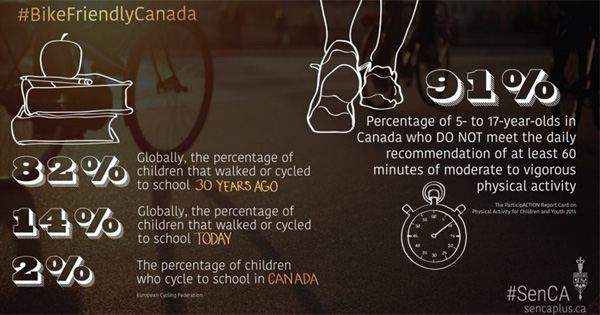The transition from summer to autumn, with back to school and back to regular routines, is always a busy time. Hopefully you’ve managed to find time for outdoor activity, taking advantage of the evening light while we still have it, and not just hiding inside, staring at screens.
Increasingly, research is telling us a few disturbing facts
- We’re not active enough to reap the numerous health benefits associated with being physically active.
- We are spending far too much time being sedentary (seated or lying down, often staring at a screen), so much so that we are at greater risk of chronic disease.
These stats apply to people of all ages, but with a new school year underway, I’d like to focus on what can be done to improve the situation for our next generation, specifically through the promotion of active transportation to and from school.

The physical activity grades are in
According to the latest ParticipACTION Report Card on Physical Activity for Children and Youth, only about a third (35%) of Canadian children and youth are active enough to get the 60 minutes of heart-pumping activity they need each day, landing us the marginal grade of D+ in Overall Physical Activity. The bad news doesn’t end there; our grade in Active Transportation is a D-, meaning that only 21% of 5-19 year olds in Canada regularly use active modes of transportation, while nearly two thirds use inactive modes, such as being dropped off by a personal vehicle or bus.
Physical activity leads to better brain health
We’re well aware that there are many reasons that children and youth should be active, but now we have yet another incentive to consider: brain health! Along with this year’s Report Card came an expert statement on physical activity and brain health in children and youth, stating, “For better brain health, all children and youth should be physically active on a regular basis. In addition to physical health benefits, physical activity also improves cognition, brain function and mental health.” (ParticipACTION, 2018). So, now that we know for sure that physical activity is not only good for the physical body but also the brain, it stands to reason that kids who are regularly active will be better set up for success in school.
Promoting active transportation, or people-powered transportation such as walking, cycling, or wheeling, has the potential to make a positive impact in many ways:
- Increased daily physical activity
- Improved overall health
- Improved mood and focus
- Improved cognition and problem-solving skills
- Decreased air pollution as a result of less vehicle reliance
This fall, consider how active school travel might work for your family or local school
- HASTe BC (Hub for Active School Travel) has a handy online Active and Safe Routes to School Toolkit that presents nine different ideas for ways to incorporate more active transportation into daily school life; this way, you can choose the option(s) that will work best for you and your school!
- Another option is Parachute Canada; it’s easy to follow and quick to implement.














Comments